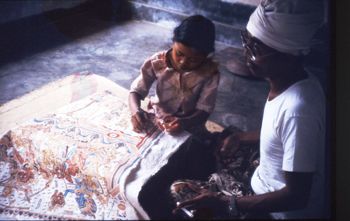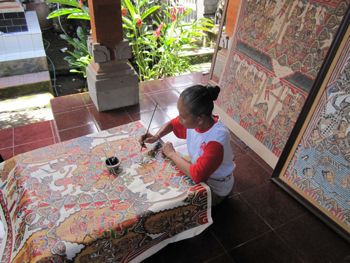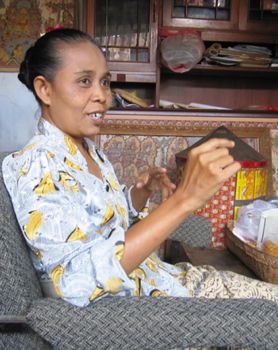A Balinese artist and temple priest builds on her father’s legacy
Siobhan Campbell
Mangku Muriati at home in her studio |
On a wet afternoon in the village of Kamasan, artist Mangku Muriati is taking a break from painting. Although she has just over a month to finish the commission she is working on, the rain provides an excuse to stop work. Flies have begun to gather on the surface of the painting, attracted by the glue she adds to the paint as a binding agent and the rice starch she uses to prime the cotton cloth. She sits crossed legged on the floor behind a low wooden table, with a section of the five metre long painting in front of her. The cloth is covered in images depicting the temptation of Arjuna, the warrior knight of the wayang tradition. In the past a painting like this was destined to adorn the pavilions of a Balinese temple, but this Kamasan painting has been ordered by a Javanese property developer for a new villa in the south of the island.
The style of painting Mangku Muriati produces dates back at least to the time of the great East Javanese kingdom of Majapahit, which flourished in the fourteenth and fifteenth centuries. Today, Kamasan remains the only village in Bali where this traditional art form has not been superseded by the adoption of new styles and materials. In her painting style, Mangku Muriati remains faithful to the time-honoured tradition, but her commentaries and choice of subject matter reveal her to be an artist with an astute eye on social and political developments in modern-day Bali.
From father to daughter
Muriati takes her work seriously. As an artist who depends largely on word of mouth for her commissions, and who contributes to the running of a large extended family, she is unwilling to produce work that might diminish her reputation, and her sales. But the financial consequences of producing inferior work are not the only considerations weighing on her mind. She feels the constant presence of her late father overseeing everything she does. Her father, Mangku Mura (1920-1999), was the most famous artist of his generation.
Unlike the other traditional painters of Kamasan, Mangku Mura did not come from a family of artists, and he lived outside Banjar Sangging, the ward of the village where painters have resided for generations. He studied with a number of senior artists from Banjar Sangging, but his studio remained within his family compound in the nearby ward of Banjar Siku. There he was also consecrated as a temple priest of a small clan temple, and he adopted the priest’s title, Mangku, as part of his name. Temples in Banjar Siku are decorated with his work, and his paintings have also been collected by museums nationally and internationally. In 1988 the Indonesian government commissioned him to produce a huge painted world map, which adorned the Indonesian pavilion at the World Expo in Brisbane, Australia.
Born in 1967, Muriati was always close to her father, and from an early age she began to assist him with colouring his paintings. However along with this apprenticeship, Mangku Mura also wanted his daughter to have a formal art school education. Consequently, Muriati was the only one of his seven children to be sent to university. For the best part of six years, she commuted by public transport from Kamasan to Denpasar, a journey of nearly two hours one way, to study fine art at Udayana University. Art school didn’t change her style of painting, but it did help her with technique, particularly the challenges facing Kamasan artists as they move from natural pigments to acrylic paint. A case in point is pere, a natural ochre coloured pigment made from rocks sourced from the island of Serangan, off the south coast of Bali. Since the 1990s, when the island was marked out for property development by Tommy Suharto and a causeway was built to connect it to the mainland, Kamasan artists have been unable to collect the ochre rocks there. Most rely on existing supplies kept buried underground to prevent oxidisation, including Muriati who is fortunate that her father stockpiled enough rocks to ensure she has an ongoing supply. However for other colours like blue and green, which are not sourced naturally, she must rely on the skills she acquired in art school to mix colour from a tube.
 |
Muriati in 1977, working on a painting with her father |
After completing her formal education, Muriati wanted to remain in Denpasar and teach Kamasan-style painting to other artists, but her father disagreed. He insisted that she return home and pursue her vocation as an artist from the family compound. Today, she receives a regular stream of visiting students, including large school groups that she hosts in the community hall opposite her house. She also receives invitations to give lectures elsewhere, but she declines most of them, because of her other duties in the village. For not only did Muriati inherit the role of artist from her father, but shortly before he died, he instructed the family that Muriati was also to take on his role as temple priest.
As guardian of her clan temple, Muriati has neither opportunity nor inclination to venture far from the village. She leads temple ceremonies, ensures the temple environs are well maintained, and serves the twenty or so households who make up her congregation. Yet although these responsibilities are time-consuming, being a temple priest is neither a full time job nor a source of income, so it is common for priests to have other employment. Normally, it is only high priests from the Brahmana or priestly caste who can devote themselves fully to religious duties. For Muriati, however, painting and priestly duties are complementary. She is scathing of other temple priests who neglect their duties because they are consumed by income-generating activities.
New directions
Not everyone agreed with Mangku Mura’s decision to name his daughter as his successor as temple priest. His decision caused some consternation in the extended family, chiefly among his younger brothers, who questioned his wisdom in nominating his then thirty-two year old daughter ahead of her three older brothers. There are no restrictions on females serving as temple priests in Bali, but it is more common for men to perform this function. The majority of female priests are in fact consecrated when their husbands assume this role. Nevertheless, the unmarried and relatively young Muriati enthusiastically embraced the challenge, and set about learning the sacred texts in preparation for her consecration ceremony. One of the few sources of support in the village for her decision to take on the role came from a female high priest from the ward of Kamasan that is home to Brahmana families. This priest had taught Muriati when she was a pupil at the local primary school in Kamasan, and they had been close associates ever since that time. When she died in 2004, Muriati received the news in a dream, in which the priest symbolically placed her headdress on the ground.
Muriati characterises her work prior to the death of her father and the purification ceremony enabling her to serve as temple priest as passive and lacking soul. But she says that the departure of Mangku Mura allowed his character to enter her and bring her work to life. She now likens the role of artist to that of a dalang or puppeteer, who must have an extensive knowledge of characters and stories. Narratives like those drawn from the Ramayana and Mahabharata epics reveal that even the best characters have minor flaws and Muriati believes that Indonesian leaders could take lessons from them. One of her paintings alludes to the collapse of the New Order government stemming from the greed of the Suharto children, which heralded a time of chaos, the fourth and final period in the cycle of the cosmos according to Hindu scripture.
 |
Muriati and her painting of the Goddess Uma |
In Muriati’s view, the ongoing natural and man-made disasters in Indonesia are evidence of the negative effect of unchecked emotion and undesirable human qualities such as dishonesty and lack of respect for leadership. The dangers posed by these qualities were foretold in the epics, and Muriati believes that they are now being manifested in Indonesian life. The most devastating of these disasters for the Balinese were the bombings of 2002 and 2005, and she is convinced these events were a sign that the Balinese must reflect on their own shortcomings in fulfilling their religious obligations. Giving expression to this conviction, several of her recent paintings explore the theme of purification or sudamala, including one which relates how the Goddess Uma is transformed into the demon goddess Durga after inadvertently consuming human blood. Another recent work was prompted by mounting evidence of impurity in the natural environment. This painting uses the story of the rice goddess, Dewi Sri, to highlight the vital role of snakes and birds in the ecosystem and to voice Muriati’s concerns about the local environment. Talking about this painting allows her to deplore the loss of farming land to villa and hotel development and major erosion along the coastline, particularly at the site of several important temples.
Muriati’s paintings update the traditional relationship between Kamasan artists and the world around them
Just as her work as a temple priest carries forward ancient traditions while reversing the gender hierarchy attached to the role, these examples of Muriati’s paintings update the traditional relationship between Kamasan artists and the world around them. In pre-colonial Bali, Kamasan artists served the royal court in Klungkung, seat of the highest royal authority in Bali, located two kilometres to the north of the village. Artists served the ruler by producing paintings for use within royal palaces and temples and were granted agricultural land in return. Today, works by Kamasan artists remain on the ceilings of two pavilions which were restored after the Dutch attack on the Klungkung palace in 1908. Many of the paintings from this time can be read as statements about the relationships between ruler and subjects, as the commoner artists were able to utilise well known scenes and characters from the epics to make veiled references to the foibles of their aristocratic rulers.
Politics and painting
In Bali today, Kamasan paintings continue to be sought by those in power. Many Balinese outside Kamasan are not familiar with the painted narratives and rely on the artists they commission to suggest an appropriate story. Large paintings adorn the walls of government buildings throughout the province, including those of the Regional Representative Council in Denpasar. Made Mangku Pastika, the Governor of Bali recently commissioned a prominent Kamasan artist to produce a major work for his home. Sometimes, it is not just the paintings themselves that are sought out by members of the ruling elite. In the 2008 local government elections, a candidate with links to the royal family approached Muriati and asked her to produce a banner in silk cloth instead of the cotton normally used by Kamasan artists. Normally, a banner like this would be produced in a pair, and hung within a temple compound, but this one was to be used as part of the candidate’s election campaign. It was to have a palace motto painted on it and according to Muriati, he planned to pray before it in an act of worship designed to enhance his political chances.
Although she privately questioned the candidate’s attempt to play up his connections with the royal house to boost his chances of election, Muriati completed the commission. When it came to the vote, he lost out to the current office holder, Wayan Candra, who is aligned to the Indonesian Democratic Party of Struggle (PDIP), something that she quietly applauded. All over Bali, the PDIP and its leader Megawati remain extremely popular, and Muriati is not reluctant about demonstrating her own allegiance to the party and its leader. When she is not dressed in white to officiate at the temple, she frequently appears in a PDIP t-shirt, knowing that her father, a great admirer of Megawati, would approve.
Like her father before her, Muriati is now thinking about who will succeed her and carry on her father’s work. Not only does she have to consider the future leadership of the clan temple but she must also ask herself who among her many nieces and nephews is going to continue the painting tradition. With the cost of a university education seemingly beyond her means, she isn’t confident that any of them will be able to follow her path of academic training. In the meantime, there is plenty of time for the forty-four year old to pursue new stories on cloth from a backlog of ideas, and to enthuse those around her in this exploration of a truly rich cultural heritage.
Siobhan Campbell (siobhanlc@hotmail.com) is a PhD student in the Department of Indonesian Studies at the University of Sydney.
Inside Indonesia 106: Oct-Dec 2011












